Deck 6: Where It Starts-Photosynthesis
Question
Question
Question
Question
Question
Question
Question
Question
Question
Question
Question
Question
Question
Question
Question
Question
Question
Question
Question
Question
Question
Question
Question
Question
Question
Question
Question
Question
Question
Question
Question
Question
Question
Question
Question
Question
Question
Question
Question
Question
Question
Question
Question
Question
Question
Question
Question
Question
Question
Question
Question
Question
Question
Question
Question
Question
Question
Question
Question
Question
Question
Question
Question
Question
Question
Question
Question
Question
Question
Question
Question
Question
Question
Question
Question
Question
Question
Question
Question
Question

Unlock Deck
Sign up to unlock the cards in this deck!
Unlock Deck
Unlock Deck
1/87
Play
Full screen (f)
Deck 6: Where It Starts-Photosynthesis
1
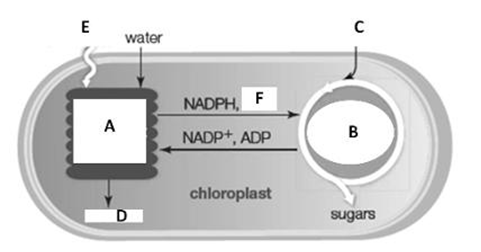
-In the accompanying figure, letter F represents ____, a product of light-dependent reactions in both the cyclic and noncyclic reactions.
A)ATP
B)oxygen
C)carbon dioxide
D)water
E)hydrogen ions
ATP
2
Which molecule is produced by the light-dependent reactions of the cyclic pathway?
A)sugar
B)NADPH
C)oxygen
D)ATP
E)water
A)sugar
B)NADPH
C)oxygen
D)ATP
E)water
D
3
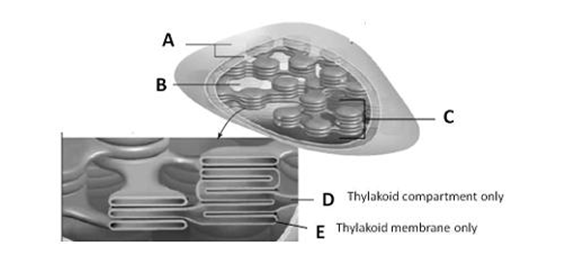
-According to the accompanying diagram, in which plant cell structure do the light-independent reactions occur?
A)A
B)B
C)C
D)D
E)E
B
4
During light-dependent reactions, ____ accumulates inside the thylakoid compartment.
A)glucose
B)hydrogen ions
C)O2
D)CO2
E)ATP
A)glucose
B)hydrogen ions
C)O2
D)CO2
E)ATP

Unlock Deck
Unlock for access to all 87 flashcards in this deck.
Unlock Deck
k this deck
5
Four of the five molecules listed below take part in the light-independent reactions. Select the exception.
A)water
B)carbon dioxide
C)RuBP (ribulose bisphosphate)
D)PGAL (phosphoglyceraldehyde)
E)PGA (phosphoglycerate)
A)water
B)carbon dioxide
C)RuBP (ribulose bisphosphate)
D)PGAL (phosphoglyceraldehyde)
E)PGA (phosphoglycerate)

Unlock Deck
Unlock for access to all 87 flashcards in this deck.
Unlock Deck
k this deck
6
Why is photorespiration an inefficient way to produce sugars?
A)Photorespiration produces 7-carbon carbohydrate molecules instead of 6-carbon sugars.
B)The increased production of O2 during photorespiration generates excess dangerous free radicals.
C)Photorespiration only occurs during the night, when the light-dependent reactions are inactive.
D)CO2 is lost instead of being fixed and ATP is required to detoxify the ammonia that is produced.
E)Carbon fixation requires an extra turn of the Calvin-Benson cycle for each molecule of sugar produced.
A)Photorespiration produces 7-carbon carbohydrate molecules instead of 6-carbon sugars.
B)The increased production of O2 during photorespiration generates excess dangerous free radicals.
C)Photorespiration only occurs during the night, when the light-dependent reactions are inactive.
D)CO2 is lost instead of being fixed and ATP is required to detoxify the ammonia that is produced.
E)Carbon fixation requires an extra turn of the Calvin-Benson cycle for each molecule of sugar produced.

Unlock Deck
Unlock for access to all 87 flashcards in this deck.
Unlock Deck
k this deck
7
How does the cyclic pathway of light-dependent reactions differ from noncyclic reactions?
A)Photolysis is performed by photosystem II in the cyclic pathway, but by photosystem II in the noncyclic pathway.
B)The noncyclic pathway uses electrons from water to produce ATP, while the cyclic pathway uses electrons from water to produce sugars.
C)The noncyclic pathway evolved before the cyclic pathway and does not produce sugars.
D)The cyclic pathway evolved before the noncyclic pathway and does not produce oxygen.
E)Although the noncyclic reactions evolved first, carbon fixation occurs in both cyclic and noncyclic reactions.
A)Photolysis is performed by photosystem II in the cyclic pathway, but by photosystem II in the noncyclic pathway.
B)The noncyclic pathway uses electrons from water to produce ATP, while the cyclic pathway uses electrons from water to produce sugars.
C)The noncyclic pathway evolved before the cyclic pathway and does not produce sugars.
D)The cyclic pathway evolved before the noncyclic pathway and does not produce oxygen.
E)Although the noncyclic reactions evolved first, carbon fixation occurs in both cyclic and noncyclic reactions.

Unlock Deck
Unlock for access to all 87 flashcards in this deck.
Unlock Deck
k this deck
8
Which enzyme catalyzes the process of carbon fixation?
A)RuBP
B)ATP synthase
C)PGAL
D)rubisco
E)thylakoid kinase
A)RuBP
B)ATP synthase
C)PGAL
D)rubisco
E)thylakoid kinase

Unlock Deck
Unlock for access to all 87 flashcards in this deck.
Unlock Deck
k this deck
9

-According to the accompanying diagram, the electron transfer chains of the light-dependent reactions are located in which plant structure(s)?
A)A only
B)B only
C)D only
D)E only
E)A and C

Unlock Deck
Unlock for access to all 87 flashcards in this deck.
Unlock Deck
k this deck
10
Under intense sunlight, ____.
A)the noncyclic pathway produces excess ATP
B)the noncyclic pathway stalls and the cyclic pathway provides extra ATP
C)excess free radicals are used to generate ATP for sugar production
D)the noncyclic pathway becomes dominant as photosystem II stops releasing electrons
E)carbon fixation ceases and leaf cells become dormant
A)the noncyclic pathway produces excess ATP
B)the noncyclic pathway stalls and the cyclic pathway provides extra ATP
C)excess free radicals are used to generate ATP for sugar production
D)the noncyclic pathway becomes dominant as photosystem II stops releasing electrons
E)carbon fixation ceases and leaf cells become dormant

Unlock Deck
Unlock for access to all 87 flashcards in this deck.
Unlock Deck
k this deck
11
Burning fossil fuels results in a net increase in the amount of CO2 released into the atmosphere because ____.
A)it releases more CO2 than burning renewable fuels such as wood
B)photosynthetic organisms cannot recapture all of the CO2 emitted by the burning of fossil fuels
C)it releases CO2 but burning renewable fuels such as wood does not
D)the release of CO2 is exacerbated by the production of CO2 during photorespiration
E)the reactions that release energy and CO2 from organic molecules differ from the reactions of aerobic respiration
A)it releases more CO2 than burning renewable fuels such as wood
B)photosynthetic organisms cannot recapture all of the CO2 emitted by the burning of fossil fuels
C)it releases CO2 but burning renewable fuels such as wood does not
D)the release of CO2 is exacerbated by the production of CO2 during photorespiration
E)the reactions that release energy and CO2 from organic molecules differ from the reactions of aerobic respiration

Unlock Deck
Unlock for access to all 87 flashcards in this deck.
Unlock Deck
k this deck
12
Chlorophyll a absorbs which color(s) of light?
A)red only
B)green only
C)violet only
D)red, violet, and orange
E)red, violet, and green
A)red only
B)green only
C)violet only
D)red, violet, and orange
E)red, violet, and green

Unlock Deck
Unlock for access to all 87 flashcards in this deck.
Unlock Deck
k this deck
13
Twelve PGAL molecules form when six carbon dioxide molecules are attached to six RuBP molecules. Only two of these PGAL molecules are needed to form a 6-carbon sugar. What is the fate of the 10 remaining PGAL molecules?
A)They are degraded.
B)They are converted back to carbon dioxide.
C)They are stored as extra PGAL molecules.
D)They are used during photorespiration.
E)They are converted to RuBP molecules.
A)They are degraded.
B)They are converted back to carbon dioxide.
C)They are stored as extra PGAL molecules.
D)They are used during photorespiration.
E)They are converted to RuBP molecules.

Unlock Deck
Unlock for access to all 87 flashcards in this deck.
Unlock Deck
k this deck
14
During times of high sugar production, some PGAL molecules that remain in the chloroplast ____.
A)undergo carbon fixation by ATP synthase
B)are assembled into lipid molecules
C)are assembled into starch molecules
D)are used to produce sucrose
E)are exported to the plant's vascular tissue
A)undergo carbon fixation by ATP synthase
B)are assembled into lipid molecules
C)are assembled into starch molecules
D)are used to produce sucrose
E)are exported to the plant's vascular tissue

Unlock Deck
Unlock for access to all 87 flashcards in this deck.
Unlock Deck
k this deck
15
In Engelmann's 1882 experiment, why did bacteria cluster in areas of red or blue wavelengths of light?
A)The bacteria used light of those wavelengths for photosynthesis.
B)Algae photosynthesized most efficiently at those wavelengths, producing needed oxygen.
C)The bacteria produced oxygen most efficiently using red and blue light.
D)Algae photosynthesized most efficiently at those wavelengths, producing needed carbon dioxide.
E)The bacteria were attracted to bright light.
A)The bacteria used light of those wavelengths for photosynthesis.
B)Algae photosynthesized most efficiently at those wavelengths, producing needed oxygen.
C)The bacteria produced oxygen most efficiently using red and blue light.
D)Algae photosynthesized most efficiently at those wavelengths, producing needed carbon dioxide.
E)The bacteria were attracted to bright light.

Unlock Deck
Unlock for access to all 87 flashcards in this deck.
Unlock Deck
k this deck
16
Why do the cells of photosynthetic organisms contain accessory pigments?
A)Accessory pigments provide a backup source of energy if the main pigment type fails.
B)Accessory pigments direct light toward the primary pigment.
C)Accessory pigments optimize the amount of energy that can be harvested in specific environments.
D)Accessory pigments provide structural support for the primary pigments.
E)Accessory pigments allow photosynthesis to occur at any time of the day.
A)Accessory pigments provide a backup source of energy if the main pigment type fails.
B)Accessory pigments direct light toward the primary pigment.
C)Accessory pigments optimize the amount of energy that can be harvested in specific environments.
D)Accessory pigments provide structural support for the primary pigments.
E)Accessory pigments allow photosynthesis to occur at any time of the day.

Unlock Deck
Unlock for access to all 87 flashcards in this deck.
Unlock Deck
k this deck
17
Discrete packages of light energy are called ____.
A)pigments
B)photons
C)chlorophylls
D)radioactive waves
E)electromagnetic particles
A)pigments
B)photons
C)chlorophylls
D)radioactive waves
E)electromagnetic particles

Unlock Deck
Unlock for access to all 87 flashcards in this deck.
Unlock Deck
k this deck
18
Light-dependent reactions in plants occur in the ____.
A)thylakoid membrane
B)plasma membrane
C)stroma
D)cytoplasm
E)stomata
A)thylakoid membrane
B)plasma membrane
C)stroma
D)cytoplasm
E)stomata

Unlock Deck
Unlock for access to all 87 flashcards in this deck.
Unlock Deck
k this deck
19
The electrons that are accepted by NADP+ to form NADPH during the noncyclic pathways of the light-dependent reactions are emitted by ____.
A)photosystem I
B)hydrogen ions
C)glucose
D)sunlight
E)ATP synthase
A)photosystem I
B)hydrogen ions
C)glucose
D)sunlight
E)ATP synthase

Unlock Deck
Unlock for access to all 87 flashcards in this deck.
Unlock Deck
k this deck
20
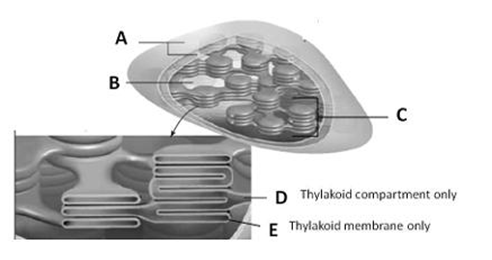
-According to the accompanying diagram, where are hydrogen ions sequestered?
A)A
B)B
C)C
D)D
E)E

Unlock Deck
Unlock for access to all 87 flashcards in this deck.
Unlock Deck
k this deck
21
Chlorophyll a, the most common photosynthetic pigment in plants, ____, giving plants their green color.
A)absorbs light of low wavelengths (400-500 nm)
B)reflects green light
C)absorbs yellow and blue light
D)absorbs green light
E)reflects red and yellow light
A)absorbs light of low wavelengths (400-500 nm)
B)reflects green light
C)absorbs yellow and blue light
D)absorbs green light
E)reflects red and yellow light

Unlock Deck
Unlock for access to all 87 flashcards in this deck.
Unlock Deck
k this deck
22
What are the products of the light-dependent reactions of photosynthesis?
A)ADP, NADP+, and sugars
B)ADP, NADP+, and O2
C)ATP, NADPH and O2
D)ATP, NADPH, and CO2
E)ATP, NADPH, and sugars
A)ADP, NADP+, and sugars
B)ADP, NADP+, and O2
C)ATP, NADPH and O2
D)ATP, NADPH, and CO2
E)ATP, NADPH, and sugars

Unlock Deck
Unlock for access to all 87 flashcards in this deck.
Unlock Deck
k this deck
23
The oxygen released during photosynthesis originates from ____.
A)carbon dioxide
B)glucose
C)ribulose bisphosphate
D)water
E)atmospheric oxygen
A)carbon dioxide
B)glucose
C)ribulose bisphosphate
D)water
E)atmospheric oxygen

Unlock Deck
Unlock for access to all 87 flashcards in this deck.
Unlock Deck
k this deck
24
The enzyme rubisco fixes carbon by attaching CO2 to ____.
A)phosphoglycerate (PGA)
B)ribulose bisphosphate (RuBP)
C)phosphoglyceraldehyde (PGAL)
D)glucose
E)oxaloacetate
A)phosphoglycerate (PGA)
B)ribulose bisphosphate (RuBP)
C)phosphoglyceraldehyde (PGAL)
D)glucose
E)oxaloacetate

Unlock Deck
Unlock for access to all 87 flashcards in this deck.
Unlock Deck
k this deck
25
Chlorophyll is found ____ of a plant cell.
A)on the outer chloroplast membrane
B)inside the mitochondria
C)in the stroma
D)in the thylakoid membrane
E)in the plant cell wall
A)on the outer chloroplast membrane
B)inside the mitochondria
C)in the stroma
D)in the thylakoid membrane
E)in the plant cell wall

Unlock Deck
Unlock for access to all 87 flashcards in this deck.
Unlock Deck
k this deck
26
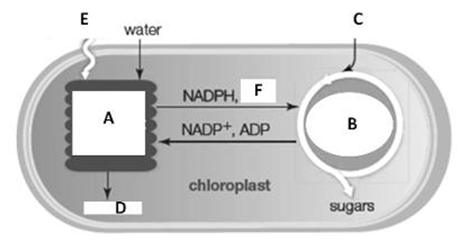
-In the accompanying figure, the reactions at letter B ____.?
A)are driven by ATP
B)generate water
C)produce NADPH
D)are dependent on light
E)produce O2

Unlock Deck
Unlock for access to all 87 flashcards in this deck.
Unlock Deck
k this deck
27
Four of the five items listed below are associated with light-dependent reactions. Select the exception.
A)photolysis
B)electron transport phosphorylation
C)carbon fixation
D)photosystems I and II
E)noncyclic pathway of ATP formation
A)photolysis
B)electron transport phosphorylation
C)carbon fixation
D)photosystems I and II
E)noncyclic pathway of ATP formation

Unlock Deck
Unlock for access to all 87 flashcards in this deck.
Unlock Deck
k this deck
28
The first event in photosynthesis is the ____.
A)movement of hydrogen ions through ATP synthase
B)absorption of a photon by a photosystem
C)fixation of carbon dioxide
D)breakdown of the thylakoid membrane
E)formation of phosphoglyceraldehyde
A)movement of hydrogen ions through ATP synthase
B)absorption of a photon by a photosystem
C)fixation of carbon dioxide
D)breakdown of the thylakoid membrane
E)formation of phosphoglyceraldehyde

Unlock Deck
Unlock for access to all 87 flashcards in this deck.
Unlock Deck
k this deck
29
The flow of hydrogen ions out of the thylakoid compartment ____.
A)provides energy to produce ATP molecules
B)recharges the photosystems
C)converts ATP into ADP
D)excites chlorophyll molecules
E)generates oxygen molecules
A)provides energy to produce ATP molecules
B)recharges the photosystems
C)converts ATP into ADP
D)excites chlorophyll molecules
E)generates oxygen molecules

Unlock Deck
Unlock for access to all 87 flashcards in this deck.
Unlock Deck
k this deck
30
Which plant(s) are adapted to hot, dry desert environments?
A)C3 plants only
B)C3 and C4 plants
C)plants that fix carbon only by the Calvin-Benson cycle
D)CAM plants
E)plants that are adapted to maximize photorespiration
A)C3 plants only
B)C3 and C4 plants
C)plants that fix carbon only by the Calvin-Benson cycle
D)CAM plants
E)plants that are adapted to maximize photorespiration

Unlock Deck
Unlock for access to all 87 flashcards in this deck.
Unlock Deck
k this deck
31
What is a key feature of autotrophs?
A)Autotrophs harvest energy directly from the environment.
B)Autotrophs do not require carbon.
C)Autotrophs obtain carbon from organic compounds.
D)Autotrophs harvest energy from decomposing organisms.
E)Autotrophs are consumers.
A)Autotrophs harvest energy directly from the environment.
B)Autotrophs do not require carbon.
C)Autotrophs obtain carbon from organic compounds.
D)Autotrophs harvest energy from decomposing organisms.
E)Autotrophs are consumers.

Unlock Deck
Unlock for access to all 87 flashcards in this deck.
Unlock Deck
k this deck
32
Which subatomic particles of a pigment absorb light?
A)electrons only
B)protons only
C)neutrons only
D)electrons and protons
E)protons and neutrons
A)electrons only
B)protons only
C)neutrons only
D)electrons and protons
E)protons and neutrons

Unlock Deck
Unlock for access to all 87 flashcards in this deck.
Unlock Deck
k this deck
33
The transport of ____ across the thylakoid membrane powers ATP production.
A)electrons
B)hydrogen ions
C)oxygen
D)carbon dioxide
E)phosphate ions
A)electrons
B)hydrogen ions
C)oxygen
D)carbon dioxide
E)phosphate ions

Unlock Deck
Unlock for access to all 87 flashcards in this deck.
Unlock Deck
k this deck
34
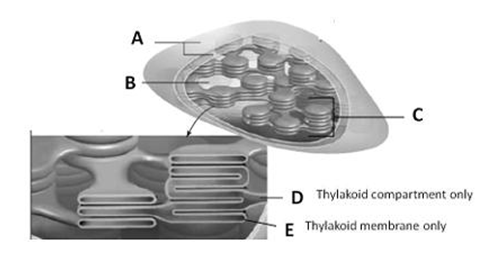
-According to the accompanying diagram, which letter indicates the chloroplast membrane?
A)A
B)B
C)C
D)D
E)E

Unlock Deck
Unlock for access to all 87 flashcards in this deck.
Unlock Deck
k this deck
35
For each molecule of CO2 that enters the Calvin-Benson cycle, ____ NADPH molecules are reduced and ____ molecules of ATP are split into ADP and Pi.
A)two; two
B)two; six
C)six; two
D)six; six
E)five; one
A)two; two
B)two; six
C)six; two
D)six; six
E)five; one

Unlock Deck
Unlock for access to all 87 flashcards in this deck.
Unlock Deck
k this deck
36
What role(s) do ATP and NADPH from the light-dependent reactions play in the conversion of PGA to PGAL in the Calvin-Benson cycle?
A)ATP donates a phosphate group and NADPH donates electrons and hydrogen.
B)ATP and NADPH both donate phosphate groups.
C)ATP provides electrons and NADPH provides a phosphate group.
D)ATP provides a carbon source and NADPH donates electrons and hydrogen.
E)ATP donates a phosphate group and NADPH provides a carbon source.
A)ATP donates a phosphate group and NADPH donates electrons and hydrogen.
B)ATP and NADPH both donate phosphate groups.
C)ATP provides electrons and NADPH provides a phosphate group.
D)ATP provides a carbon source and NADPH donates electrons and hydrogen.
E)ATP donates a phosphate group and NADPH provides a carbon source.

Unlock Deck
Unlock for access to all 87 flashcards in this deck.
Unlock Deck
k this deck
37
Which type(s) of plants have adapted to hot, dry conditions by minimizing photorespiration?
A)C3 only
B)C4 only
C)CAM only
D)C3 and CAM
E)C4 and CAM
A)C3 only
B)C4 only
C)CAM only
D)C3 and CAM
E)C4 and CAM

Unlock Deck
Unlock for access to all 87 flashcards in this deck.
Unlock Deck
k this deck
38
How is the process of carbon fixation necessary for plant growth?
A)Carbon fixation extracts carbons from organic plant sugars to be used for energy.
B)Carbon fixation incorporates carbon from PGAL into sugar molecules.
C)Carbon fixation extracts carbon from an inorganic source (CO2) and uses it to build sugars.
D)Carbon fixation extracts carbon from an inorganic source (CO2) to produce O2 needed for plant growth.
E)Carbon fixation regenerates carbon to be used in the light-dependent reactions for ATP production.
A)Carbon fixation extracts carbons from organic plant sugars to be used for energy.
B)Carbon fixation incorporates carbon from PGAL into sugar molecules.
C)Carbon fixation extracts carbon from an inorganic source (CO2) and uses it to build sugars.
D)Carbon fixation extracts carbon from an inorganic source (CO2) to produce O2 needed for plant growth.
E)Carbon fixation regenerates carbon to be used in the light-dependent reactions for ATP production.

Unlock Deck
Unlock for access to all 87 flashcards in this deck.
Unlock Deck
k this deck
39
What are the molecular reactants for photosynthesis in plants?
A)H2O only
B)CO2 only
C)O2 only
D)both CO2 and O2
E)both CO2 and H2O
A)H2O only
B)CO2 only
C)O2 only
D)both CO2 and O2
E)both CO2 and H2O

Unlock Deck
Unlock for access to all 87 flashcards in this deck.
Unlock Deck
k this deck
40
Openings in leaves through which gases enter and exit are called ____.
A)mesophylls
B)stroma
C)rubiscos
D)stomata
E)photosystems
A)mesophylls
B)stroma
C)rubiscos
D)stomata
E)photosystems

Unlock Deck
Unlock for access to all 87 flashcards in this deck.
Unlock Deck
k this deck
41
ß-carotene ____.
A)absorbs yellow and orange light
B)is the major pigment found in plant cells
C)and chlorophyll a absorb light of the same wavelength
D)is an accessory pigment
E)reflects green light
A)absorbs yellow and orange light
B)is the major pigment found in plant cells
C)and chlorophyll a absorb light of the same wavelength
D)is an accessory pigment
E)reflects green light

Unlock Deck
Unlock for access to all 87 flashcards in this deck.
Unlock Deck
k this deck
42
Match the description to the correct photosynthetic pathway.
a.light-dependent reactions in the noncyclic pathway
b.light-dependent reactions in the cyclic pathway
c.Calvin-Benson cycle
d.C4 pathway
e.photorespiration
This process involves a photolysis step, breaking water into hydrogen ions and oxygen.
a.light-dependent reactions in the noncyclic pathway
b.light-dependent reactions in the cyclic pathway
c.Calvin-Benson cycle
d.C4 pathway
e.photorespiration
This process involves a photolysis step, breaking water into hydrogen ions and oxygen.

Unlock Deck
Unlock for access to all 87 flashcards in this deck.
Unlock Deck
k this deck
43
Match each process or structure with its correct location within the chloroplast. Some choices may be used more than once.
a.thylakoid membrane
b.stroma
c.thylakoid compartment
formation of ATP
a.thylakoid membrane
b.stroma
c.thylakoid compartment
formation of ATP

Unlock Deck
Unlock for access to all 87 flashcards in this deck.
Unlock Deck
k this deck
44
Match each process or structure with its correct location within the chloroplast. Some choices may be used more than once.
a.thylakoid membrane
b.stroma
c.thylakoid compartment
Calvin-Benson cycle
a.thylakoid membrane
b.stroma
c.thylakoid compartment
Calvin-Benson cycle

Unlock Deck
Unlock for access to all 87 flashcards in this deck.
Unlock Deck
k this deck
45
Match each process or structure with its correct location within the chloroplast. Some choices may be used more than once.
a.thylakoid membrane
b.stroma
c.thylakoid compartment
electron transport chain
a.thylakoid membrane
b.stroma
c.thylakoid compartment
electron transport chain

Unlock Deck
Unlock for access to all 87 flashcards in this deck.
Unlock Deck
k this deck
46
Which gas is released into the environment when organic material is burned?
A)O2
B)CO2
C)N2
D)H2
E)Cl2
A)O2
B)CO2
C)N2
D)H2
E)Cl2

Unlock Deck
Unlock for access to all 87 flashcards in this deck.
Unlock Deck
k this deck
47
Four of the five items listed below participate in photosynthesis. Select the exception.
A)photosystem
B)chlorophyll
C)mitochondrion
D)chloroplast
E)thylakoid membrane
A)photosystem
B)chlorophyll
C)mitochondrion
D)chloroplast
E)thylakoid membrane

Unlock Deck
Unlock for access to all 87 flashcards in this deck.
Unlock Deck
k this deck
48
Match each process or structure with its correct location within the chloroplast. Some choices may be used more than once.
a.thylakoid membrane
b.stroma
c.thylakoid compartment
photosystems I and II
a.thylakoid membrane
b.stroma
c.thylakoid compartment
photosystems I and II

Unlock Deck
Unlock for access to all 87 flashcards in this deck.
Unlock Deck
k this deck
49
In the cyclic pathway of the light-dependent reactions, electrons ejected from photosystem I enter the electron transport system before returning to ____.
A)photosystem II
B)photosystem I
C)the stroma
D)the outer chloroplast membranes
E)ATP synthase
A)photosystem II
B)photosystem I
C)the stroma
D)the outer chloroplast membranes
E)ATP synthase

Unlock Deck
Unlock for access to all 87 flashcards in this deck.
Unlock Deck
k this deck
50
Match the description to the correct photosynthetic pathway.
a.light-dependent reactions in the noncyclic pathway
b.light-dependent reactions in the cyclic pathway
c.Calvin-Benson cycle
d.C4 pathway
e.photorespiration
In this process, rubisco attaches oxygen (instead of carbon dioxide) to RuBP.
a.light-dependent reactions in the noncyclic pathway
b.light-dependent reactions in the cyclic pathway
c.Calvin-Benson cycle
d.C4 pathway
e.photorespiration
In this process, rubisco attaches oxygen (instead of carbon dioxide) to RuBP.

Unlock Deck
Unlock for access to all 87 flashcards in this deck.
Unlock Deck
k this deck
51
The wavelength of visible light with the highest energy is ____.
A)violet
B)blue
C)yellow
D)orange
E)red
A)violet
B)blue
C)yellow
D)orange
E)red

Unlock Deck
Unlock for access to all 87 flashcards in this deck.
Unlock Deck
k this deck
52
Match the description to the correct photosynthetic pathway.
a.light-dependent reactions in the noncyclic pathway
b.light-dependent reactions in the cyclic pathway
c.Calvin-Benson cycle
d.C4 pathway
e.photorespiration
In this process, one six-carbon sugar is formed from two molecules of phosphoglyceraldehyde.
a.light-dependent reactions in the noncyclic pathway
b.light-dependent reactions in the cyclic pathway
c.Calvin-Benson cycle
d.C4 pathway
e.photorespiration
In this process, one six-carbon sugar is formed from two molecules of phosphoglyceraldehyde.

Unlock Deck
Unlock for access to all 87 flashcards in this deck.
Unlock Deck
k this deck
53

-In the accompanying diagram, ATP synthase pumps hydrogen ions into which space?
A)A
B)B
C)C
D)D
E)E

Unlock Deck
Unlock for access to all 87 flashcards in this deck.
Unlock Deck
k this deck
54
Electrons lost by chlorophyll are replaced by electrons donated from ____.
A)NADPH
B)sunlight
C)water
D)carbon dioxide
E)ATP
A)NADPH
B)sunlight
C)water
D)carbon dioxide
E)ATP

Unlock Deck
Unlock for access to all 87 flashcards in this deck.
Unlock Deck
k this deck
55
Match each process or structure with its correct location within the chloroplast. Some choices may be used more than once.
a.thylakoid membrane
b.stroma
c.thylakoid compartment
accumulation of hydrogen ions
a.thylakoid membrane
b.stroma
c.thylakoid compartment
accumulation of hydrogen ions

Unlock Deck
Unlock for access to all 87 flashcards in this deck.
Unlock Deck
k this deck
56
Match each process or structure with its correct location within the chloroplast. Some choices may be used more than once.
a.thylakoid membrane
b.stroma
c.thylakoid compartment
ATP synthase
a.thylakoid membrane
b.stroma
c.thylakoid compartment
ATP synthase

Unlock Deck
Unlock for access to all 87 flashcards in this deck.
Unlock Deck
k this deck
57
Match the description to the correct photosynthetic pathway.
a.light-dependent reactions in the noncyclic pathway
b.light-dependent reactions in the cyclic pathway
c.Calvin-Benson cycle
d.C4 pathway
e.photorespiration
This process yields ATP but not NADPH or oxygen.
a.light-dependent reactions in the noncyclic pathway
b.light-dependent reactions in the cyclic pathway
c.Calvin-Benson cycle
d.C4 pathway
e.photorespiration
This process yields ATP but not NADPH or oxygen.

Unlock Deck
Unlock for access to all 87 flashcards in this deck.
Unlock Deck
k this deck
58
Match the description to the correct photosynthetic pathway.
a.light-dependent reactions in the noncyclic pathway
b.light-dependent reactions in the cyclic pathway
c.Calvin-Benson cycle
d.C4 pathway
e.photorespiration
In this process, carbon is fixed twice: once in mesophyll cells and again in bundle sheath cells.
a.light-dependent reactions in the noncyclic pathway
b.light-dependent reactions in the cyclic pathway
c.Calvin-Benson cycle
d.C4 pathway
e.photorespiration
In this process, carbon is fixed twice: once in mesophyll cells and again in bundle sheath cells.

Unlock Deck
Unlock for access to all 87 flashcards in this deck.
Unlock Deck
k this deck
59
For each six atoms of carbon derived from CO2 fixed in the light-independent reactions, how many molecules of PGAL (phosphoglyceraldehyde) are produced?
A)2
B)3
C)6
D)12
E)15
A)2
B)3
C)6
D)12
E)15

Unlock Deck
Unlock for access to all 87 flashcards in this deck.
Unlock Deck
k this deck
60
The cyclic pathway of light-dependent reactions uses ____ to absorb light energy and emit electrons.
A)photosystems I and II
B)photosystem II only
C)photosystem I only
D)ß-carotene
E)ATP synthase
A)photosystems I and II
B)photosystem II only
C)photosystem I only
D)ß-carotene
E)ATP synthase

Unlock Deck
Unlock for access to all 87 flashcards in this deck.
Unlock Deck
k this deck
61
Which energy sources drive the light-dependent and light-independent reactions of photosynthesis?



Unlock Deck
Unlock for access to all 87 flashcards in this deck.
Unlock Deck
k this deck
62
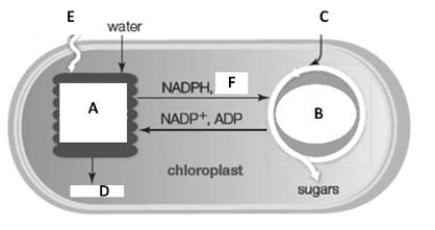
-In the accompanying figure, what does letter E represent?
A)carbon dioxide
B)light energy
C)glucose
D)ATP
E)oxygen

Unlock Deck
Unlock for access to all 87 flashcards in this deck.
Unlock Deck
k this deck
63
Match each process or structure with its correct location within the chloroplast. Some choices may be used more than once.
a.thylakoid membrane
b.stroma
c.thylakoid compartment
photolysis
a.thylakoid membrane
b.stroma
c.thylakoid compartment
photolysis

Unlock Deck
Unlock for access to all 87 flashcards in this deck.
Unlock Deck
k this deck
64
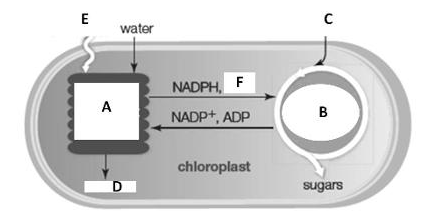
-In the accompanying figure, letter D denotes which photosynthetic product?

Unlock Deck
Unlock for access to all 87 flashcards in this deck.
Unlock Deck
k this deck
65
Match each term to its most suitable description.
a.absorbs light
b.converts light to chemical energy
c.organisms that make their own food
d.process that is minimized in C4 and CAM plants
e.organisms that obtain energy from consuming other organisms
autotroph
a.absorbs light
b.converts light to chemical energy
c.organisms that make their own food
d.process that is minimized in C4 and CAM plants
e.organisms that obtain energy from consuming other organisms
autotroph

Unlock Deck
Unlock for access to all 87 flashcards in this deck.
Unlock Deck
k this deck
66
Match each term to its most suitable description.
a.absorbs light
b.converts light to chemical energy
c.organisms that make their own food
d.process that is minimized in C4 and CAM plants
e.organisms that obtain energy from consuming other organisms
photorespiration
a.absorbs light
b.converts light to chemical energy
c.organisms that make their own food
d.process that is minimized in C4 and CAM plants
e.organisms that obtain energy from consuming other organisms
photorespiration

Unlock Deck
Unlock for access to all 87 flashcards in this deck.
Unlock Deck
k this deck
67
Match each term to its most suitable description.
a.absorbs light
b.converts light to chemical energy
c.organisms that make their own food
d.process that is minimized in C4 and CAM plants
e.organisms that obtain energy from consuming other organisms
heterotroph
a.absorbs light
b.converts light to chemical energy
c.organisms that make their own food
d.process that is minimized in C4 and CAM plants
e.organisms that obtain energy from consuming other organisms
heterotroph

Unlock Deck
Unlock for access to all 87 flashcards in this deck.
Unlock Deck
k this deck
68
How do C4 and CAM plants survive under dry conditions?

Unlock Deck
Unlock for access to all 87 flashcards in this deck.
Unlock Deck
k this deck
69
Match the process to the correct description.
-formation of glucose
A)Rubisco attaches CO2 to RuBP.
B)ATP and NADPH are required.
C)Two PGALs combine to form a six-carbon product.
D)O2, ATP, and NADPH are produced.
E)An electron transport system produces ATP but not NADPH.
-formation of glucose
A)Rubisco attaches CO2 to RuBP.
B)ATP and NADPH are required.
C)Two PGALs combine to form a six-carbon product.
D)O2, ATP, and NADPH are produced.
E)An electron transport system produces ATP but not NADPH.

Unlock Deck
Unlock for access to all 87 flashcards in this deck.
Unlock Deck
k this deck
70
Match the process to the correct description.
a.Rubisco attaches CO2 to RuBP.b.ATP and NADPH are required.c.Two PGALs combine to form a six-carbon product.d.O2, ATP, and NADPH are produced.e.An electron transport system produces ATP but not NADPH.
PGA to PGAL conversion
a.Rubisco attaches CO2 to RuBP.b.ATP and NADPH are required.c.Two PGALs combine to form a six-carbon product.d.O2, ATP, and NADPH are produced.e.An electron transport system produces ATP but not NADPH.
PGA to PGAL conversion

Unlock Deck
Unlock for access to all 87 flashcards in this deck.
Unlock Deck
k this deck
71
Match each term to its most suitable description.
a.absorbs light
b.converts light to chemical energy
c.organisms that make their own food
d.process that is minimized in C4 and CAM plants
e.organisms that obtain energy from consuming other organisms
photosynthesis
a.absorbs light
b.converts light to chemical energy
c.organisms that make their own food
d.process that is minimized in C4 and CAM plants
e.organisms that obtain energy from consuming other organisms
photosynthesis

Unlock Deck
Unlock for access to all 87 flashcards in this deck.
Unlock Deck
k this deck
72
Match each term to its most suitable description.
a.absorbs light
b.converts light to chemical energy
c.organisms that make their own food
d.process that is minimized in C4 and CAM plants
e.organisms that obtain energy from consuming other organisms
pigment
a.absorbs light
b.converts light to chemical energy
c.organisms that make their own food
d.process that is minimized in C4 and CAM plants
e.organisms that obtain energy from consuming other organisms
pigment

Unlock Deck
Unlock for access to all 87 flashcards in this deck.
Unlock Deck
k this deck
73
Match the process to the correct description.
a.Rubisco attaches CO2 to RuBP.b.ATP and NADPH are required.c.Two PGALs combine to form a six-carbon product.d.O2, ATP, and NADPH are produced.e.An electron transport system produces ATP but not NADPH.
carbon dioxide fixation
a.Rubisco attaches CO2 to RuBP.b.ATP and NADPH are required.c.Two PGALs combine to form a six-carbon product.d.O2, ATP, and NADPH are produced.e.An electron transport system produces ATP but not NADPH.
carbon dioxide fixation

Unlock Deck
Unlock for access to all 87 flashcards in this deck.
Unlock Deck
k this deck
74
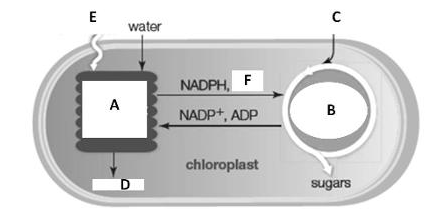
-In the accompanying figure, the reactions at letter A ____.
A)are driven by ATP
B)generate water
C)require NADPH
D)are dependent on light
E)comprise the Calvin-Benson cycle

Unlock Deck
Unlock for access to all 87 flashcards in this deck.
Unlock Deck
k this deck
75
What is the chemical relationship between the light-dependent and light-independent reactions of photosynthesis?
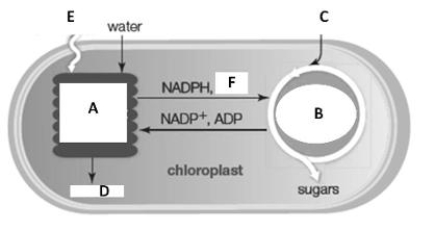


Unlock Deck
Unlock for access to all 87 flashcards in this deck.
Unlock Deck
k this deck
76
Match the process to the correct description.
a.Rubisco attaches CO2 to RuBP.b.ATP and NADPH are required.c.Two PGALs combine to form a six-carbon product.d.O2, ATP, and NADPH are produced.e.An electron transport system produces ATP but not NADPH.
cyclic pathway
a.Rubisco attaches CO2 to RuBP.b.ATP and NADPH are required.c.Two PGALs combine to form a six-carbon product.d.O2, ATP, and NADPH are produced.e.An electron transport system produces ATP but not NADPH.
cyclic pathway

Unlock Deck
Unlock for access to all 87 flashcards in this deck.
Unlock Deck
k this deck
77
A cat eats a bird, which ate a caterpillar, which chewed on a weed. Which organisms are autotrophs? Which ones are heterotrophs?
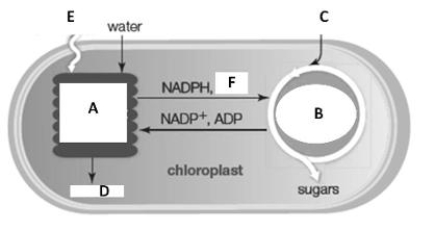


Unlock Deck
Unlock for access to all 87 flashcards in this deck.
Unlock Deck
k this deck
78
Match the process to the correct description.
a.Rubisco attaches CO2 to RuBP.b.ATP and NADPH are required.c.Two PGALs combine to form a six-carbon product.d.O2, ATP, and NADPH are produced.e.An electron transport system produces ATP but not NADPH.
noncyclic pathway
a.Rubisco attaches CO2 to RuBP.b.ATP and NADPH are required.c.Two PGALs combine to form a six-carbon product.d.O2, ATP, and NADPH are produced.e.An electron transport system produces ATP but not NADPH.
noncyclic pathway

Unlock Deck
Unlock for access to all 87 flashcards in this deck.
Unlock Deck
k this deck
79
How did Theodor Engelmann determine which colors of light were optimal for driving photosynthesis?

Unlock Deck
Unlock for access to all 87 flashcards in this deck.
Unlock Deck
k this deck
80
What do photosynthetic autotrophs use as a carbon source? What do they use as an energy source?

Unlock Deck
Unlock for access to all 87 flashcards in this deck.
Unlock Deck
k this deck



